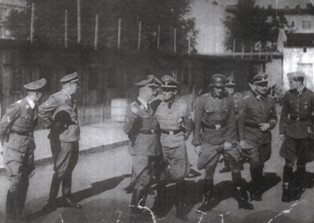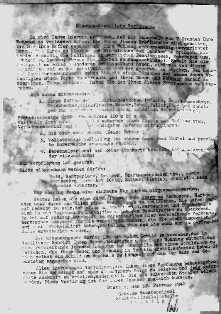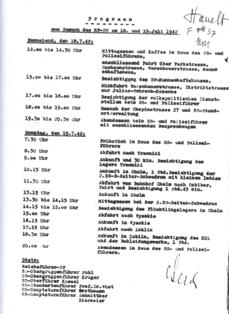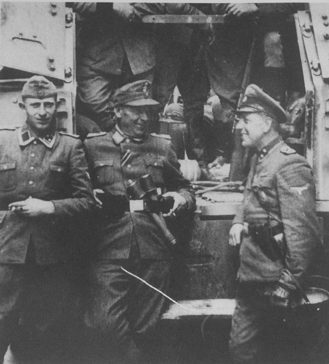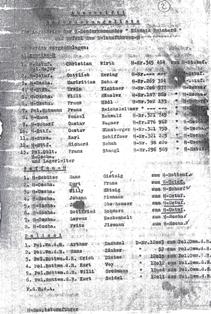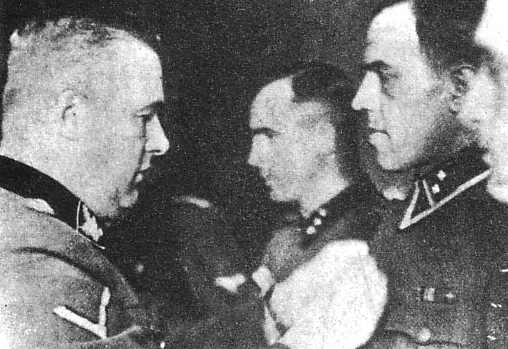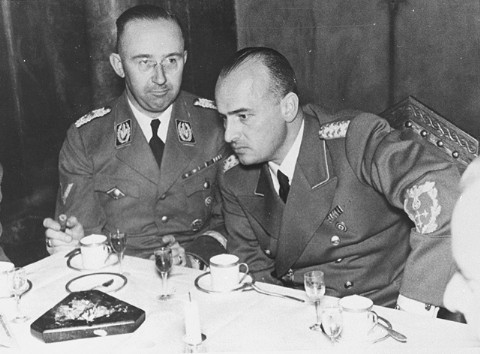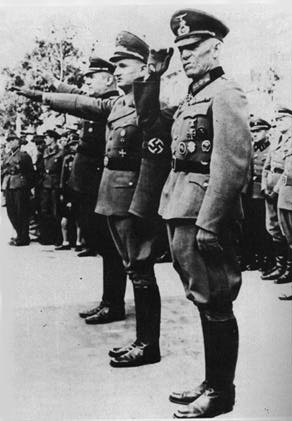Holocaust Education & Archive Research Team |
Aktion Reinhard
A-R Leadership A-R Articles
Action Erntefest Modern Research
| |||||
Himmler Visits “Aktion Reinhard” Facilities
The preparation for the extermination of the Jews of the Generalgouvernement had actually started months before the "Wannsee Conference". A special organisation was formed which came to be called “Aktion Reinhard”, probably named in honour of Reinhard Heydrich after his assassination in Prague.
This organisation was established under the command of SS and Police Leader Lublin Odilo Globocnik, who had been appointed by Himmler, to manage the murder programme.
Towards the end of 1941 it was decided that the KL Majdanek would also serve as a camp for Soviet POWs. He also ordered the expansion of the work camp 7 Lipowa Street, and the settlement of Germans in the Zamosc region. On 19 July 1942, on the eve of the Great Action concerning the Jews of Warsaw, Himmler visited Sobibor, one of the “Aktion Reinhard” death camps in the Lublin area. On the same tour he also visited the SS Training Camp at Trawniki, where a number of photographs were taken.
He ended his tour with a visit to the “Aktion Reinhard” headquarters in Lublin, and following discussions with Globocnik, concluded that with the completion of the death camps, the Jews of the Generalgouvernement could be exterminated. In early March 1943, Himmler once again visited the “Aktion Reinhard” Headquarters and the death camps of Sobibor and Treblinka. In anticipation of Himmler’s visit the camps were thoroughly cleansed. Karl Frenzel (Sobibor), testified at his trial regarding this visit:
"The visit was announced a few days ahead. The leadership of the camp took steps to make order in the camp… I was ordered, toget her with some Unterführer’s and Ukrainian guards, to take over the outside security of the camp and guarantee Himmler’s personal security. When Himmler visited the gassing installation in Camp III, I guarded the surrounding area.
I remember that afterwards all the Unterführer were assembled in the canteen, and Himmler delivered an address to them…”
In honour of Himmler’s visit a special gassing of several hundred young Jewish girls took place. This is confirmed by the testimony of SS-Oberscharführer Hubert Gomerski who served at Sobibor:
"I remember the visit of Reichsführer Heinrich Himmler in Sobibor, I saw Himmler with the whole group going in the direction of Camp III." Himmler also visited Treblinka, along with a group of about twenty people. Franz Stangl the Camp Commandant, and Kurt Franz, his deputy showed them the camp. The entourage went to the Lazarett, quickly by-passing the huts, and subsequently inspected the extermination area, where they stayed for half an hour.
During his visit to Treblinka, Himmler learnt that despite his orders, the corpses of the Jews had been buried and not cremated. In order to destroy all traces of the mass extermination, he commanded that the corpses be cremated, and this activity became the main task in the camp’s final months. In addition Himmler decided to send transports from Holland to Sobibor, as well as transports from the Balkan Countries, Bulgaria, and Greece to Treblinka. This decision did not change Himmler’s overall conclusion that “Aktion Reinhard” was basically completed, and its camps were to be closed once these transports and the cremations had ceased.
Himmler was impressed with the efficiency and dedication of the “Aktion Reinhard” camps staff, concluding his visit with a decision to promote the commanding officers and NCOs who had played a major part in the extermination action.
Globocnik wrote to SS-Gruppenführer Maximillian von Herff, the head of the SS Personal Main Office in a letter dated 13 April 1943, stating “The SS-Reichsführer, on the occasion of his visit to “Aktion Reinhard” installations in March, as I have already verbally informed you, has approved the promotion of the best men and commanders who are engaged in this action.”
In the proposed concentration camp a depot for booty ammunition was to be established. Himmler’s order that Sobibor was to become a concentration camp meant that it would now be subordinated to Pohl, and not Globocnik.
After discussion with Globocnik, Pohl wrote to Himmler on 15 July, suggesting that the changes the Reichsführer-SS wanted could be achieved without a change of designation or control.
On 24 July 1943, Pohl was informed that Himmler agreed to his proposal, and activity commenced in Sobibor to rebuild the whole north east section close to the railway station with bunkers and barracks to store the ammunition. Following a conference held by Hans Frank in Krakow on 19 October 1943, five days after the revolt in Sobibor, the issue of the Jews in the labour camps was raised.
Whilst inspections were recommended, Himmler decided to annihilate the Jews in the labour camps immediately. Himmler instructed Krüger to carry out the liquidation order.
Krüger delegated this mission to Jakob Sporrenberg, who had replaced Globocnik as SSPF Lublin. This operation was given the code name “Aktion Erntefest” (“Action Harvest Festival”) and was carried out in November 1943. Approximately 42,000 Jews were murdered during this last mass killing of the Jews within the Generalgouvernement.
From Trieste, Globocnik bombarded Himmler with correspondence; including the fiscal statements for “Aktion Reinhard” on 5 January 1944. Himmler replied that Globocnik had performed a great and unique service for the German people. Himmler and Globocnik were partners in crime, the most monstrous crime in history.
Who’s Who in Nazi Germany, by Robert S Wistrich, published by Routledge London 1995. The Final Solution, by Gerald Reitlinger, published by Valentine and Mitchell 1953.
Copyright. Chris Webb H.E.A.R.T 2007
|
